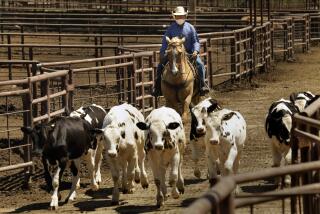Helping Beef Lean Up Its Act
- Share via
We’d like to think that Americans had nearly given up eating red meat by now. But nothing could be further from the truth. After a drop in beef consumption that began in the mid-1970s, the National Cattlemen’s Beef Assn. reports that demand increased 5% in the second quarter of 2001 compared with the second quarter of 2000, and that demand has increased in 10 of the past 12 quarters. In fact, the NCBA reports, the annual per capita consumption of beef is 66.2 pounds, compared with 50.5 pounds for pork and 55.8 pounds for chicken.
There is nothing inherently wrong with beef. It contains good amounts of vitamins B-6 and B-12, as well as iron and other vitamins and minerals. The downside, of course, is that beef can be high in saturated fat and cholesterol, depending upon cut and preparation.
But despite a high saturated-fat content and overseas scares about “mad cow disease,” Americans are not fleeing from beef, and it’s time for advice about how to incorporate it into a sensible, low-fat diet. The California Beef Council offers these tips:
* Purchase lean meats closely trimmed of fat, or trim them yourself at home. Choose one of beef’s “skinniest six” cuts: top round, top loin, round tip, eye of round, sirloin and tenderloin. A 3-ounce cooked serving of these cuts contains fewer than 8 grams of total fat and under 3 grams of saturated fat.
* For every 3 ounces of cooked beef, start with 4 ounces of uncooked meat. Three ounces of cooked beef is about the size of a deck of cards.
* Keep lean beef lean. Broil or roast it on a rack; avoid frying; saute and brown in a nonstick skillet.
* Marinate with spices, wine or lemon, not oil.
* Cook soups, stews, chili and spaghetti sauces the day before, and refrigerate. Skim off any solid fat.
* For light eaters, divide a steak into two servings.
* Partially freeze meat to trim fat, and slice thin for stir-frying.
* After browning ground beef, drain it in a colander or on a paper towel; and rinse drained ground beef with hot water.
* Avoid salting foods until you taste it, and then only if you must. Salt delays browning in meat and can draw out moisture.
* Use beef as an appetizer, and make the entree high in vegetables and other low-fat foods.
*
Dr. Sheldon Margen is a professor of public health at UC Berkeley; Dale A. Ogar is managing editor of the UC Berkeley Wellness Letter. Send questions to Dale Ogar, School of Public Health, UC Berkeley, Berkeley, CA 94720-7360, or e-mail to daogar@uclink4.berkeley.edu. Eating Smart appears the second and fourth Mondays of the month.
More to Read
Eat your way across L.A.
Get our weekly Tasting Notes newsletter for reviews, news and more.
You may occasionally receive promotional content from the Los Angeles Times.





